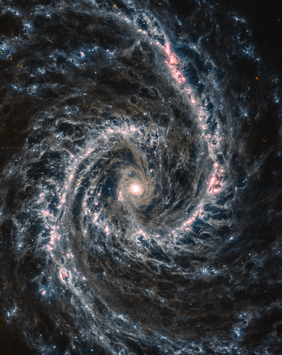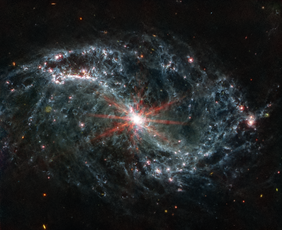Using NASA's James Webb Space Telescope's unprecedented image clarity at infrared wavelengths, scientists are getting a new look at stars, gas and dust in nearby galaxies that will reveal missing pieces of the star formation puzzle. The new amazing observations have now enabled a collection of 17 research papers, also with first authors from the Center for Astronomy at Heidelberg University. These have now been published in a special focus issue of The Astrophysical Journal Letters.
The largest survey of nearby galaxies in Webb’s first year of science operations is being carried out by the "Physics at High Angular resolution in Nearby Galaxies (PHANGS for short)" collaboration, involving more than 100 researchers from around the globe. Also Astronomers of the Center for Astronomy at Heidelberg University (ZAH) are participating in this exciting project.
The PHANGS team is studying a sample of 19 spiral galaxies and has spent years observing these galaxies at optical, radio, and ultraviolent wavelengths using NASA’s Hubble Space Telescope, the Atacama Large Millimeter/Submillimeter Array, and the Very Large Telescope’s Multi Unit Spectroscopic Explorer of the European Southern Observatory. But the earliest stages of a star’s lifecycle have remained out of view because the process is enshrouded within gas and dust clouds.
Webb’s powerful infrared capabilities however can pierce through the dust to connect the missing puzzle pieces. In Webb’s first few months of science operations, five of the PHANGS targets where observed: the galaxies M74, NGC 7496, IC 5332, NGC 1365, and NGC 1433. The results are already astounding astronomers.
The latest images from Webb’s Mid-Infrared Instrument (MIRI) reveal the presence of a network of highly structured features within these galaxies, glowing cavities of dust and huge cavernous bubbles of gas that line the spiral arms. In some regions this web of features appears built from both individual and overlapping shells and bubbles where young stars are releasing energy.
At specific wavelengths observable by MIRI one is sensitive to emission from polycyclic aromatic hydrocarbons (PAHs), which play a critical role in the formation of stars and planets. These molecules were detected by Webb's first observations by the PHANGS program.
Dr Kathryn Kreckel, Emmy Noether Research Group Leader at Heidelberg University's Center for Astronomy (ZAH), leads the PHANGS science working group that studies the connection between gas ionization and star formation.
Dr Oleg Egorov, postdoc researcher in Kreckel's research group, in particular used Webb to study PAHs which are ubiquitous in the interstellar medium. Their emission is often a dominant feature in the mid-infrared range, so they are served as tracer of the physical and chemical processes in the interstellar medium. From studies made using previous-generation infrared space telescopes it was known that PAHs are less abundant in regions of ionized hydrogen gas which are called "HII-regions" by astronomers. But what process regulates this remained unclear.
"Thanks to JWST, we were able to relate the properties of PAHs and found that their abundance strongly depends on the intensity of the ionizing ultraviolet radiation in HII regions, while the metallicity of the interstellar medium and the hardness of ultraviolet radiation plays only a minor role, contrary to what was thought before", Dr Egorov explains.
Oleg Egorov emphasises that it would not have been possible at all to measure the properties of PAHs with ground-based telescopes alone because it requires observations in mid-infrared range inaccessible from earths surface. JWST is the first instrument that allows measuring the properties of PAH molecules in individual HII regions or molecular clouds in relatively distant galaxies.
To him one of the many exciting things about working in a big team like the PHANGS collaboration is that the team joins together people with various expertise, skills and interests. "Immediately after the first data arrived, we all together started to think about how to interpret the information on the structures that we see in the interstellar medium and have never seen before in such galaxies," Oleg Egorov explains. "Thanks to this collaborative effort, the team obtained many new scientific results ready for publishing already now, only half a year after receiving the first JWST images - this is very exciting!" Egorov describes his experiences.
But studying interactions at the finest scale can also help provide insights into the larger picture of how galaxies have evolved over time.
Dr Elizabeth Watkins, who also works in Kathryn Kreckel's reseach group, together with her collaborators for example studied a single galaxy 30 million light years away, and found 1700 bubbles, or pockets of hot expanding gas. They drive thin shells of colder gas and dust, which appear as holes in 2D images. The smallest examples were 40 light years, but some reached up to 3000 light years across. "These bubbles are driven by young stars that have recently formed together. With their combined energy, the stars create such bubbles. Because of this, they contain an imprint of the properties and conditions needed to form stars in the first place," Dr Watkins explains her findings.
Watkins called JWST vital for this result. On Earth, the atmosphere absorbs the infrared light that was used to detect the edges of these bubbles. But infrared light is great for tracing dust, which traces the dense, cold gas from that stars form. Without air in space, the light reached Webb undistorted by swirls in the atmosphere. This allowed Watkins and her collaborators to receive exceptionally sharp images, which were needed to identify the smallest bubbles.
"In the beginning, there was a huge rush to reduce our data from the moment it was live. We got around 10 people together in one room where we were reducing the data and generating comparison plots. At the end of the day, we passed our work along to teams in the USA for them to continue," Watkins describes her experience with JWST. "Being part of the joint effort, and working together to produce not only this paper, but 20 additional papers, was very rewarding and I have learnt so much in the past 6 months as a result," remembers Dr. Watkins.
Also the ZAH research group of Dr. Mélanie Chevance at uses JWST data to study star formation proessees in galaxies. Her PhD student Jaeyeon Kim was for the first time able to perform measurements of the embedded phase of star formation for a distant galaxy and to identify key environmental factors that are responsible for regulating the early phase of star formation.
Stars form deeply embedded in their natal cloud and therefore any emission from these newly formed stars is absorbed by the surrounding gas and invisible to us. The only way to detect this early phase is to capture the reprocessed light by the surrounding dust grains, which emit radiation in the infrared now captured with Webb.
To Kim it was a pleasure to work with JWST images. "When I first saw the images, I was shocked to see how pretty and different the galaxies looked compared to pre-JWST images," Kim remembers her feelings and adds that she had received huge help and guidance from all the experts in PHANGS. "It was an honor that I was given the chance to handle these beautiful images as a PhD student," Jaeyeon Kim describes her experience in the PHANGS team.
The PHANGS team will work to create and release data sets that align Webb’s data to each of the complementary data sets obtained previously from the other observatories, to help accelerate discovery by the broader astronomical community.
Thanks to Webb’s resolution, for the first time it became possible to conduct a complete census of star formation, and take inventories of the interstellar medium bubble structures in nearby galaxies beyond the Local Group. That census will help understanding how star formation and its feedback imprint themselves on the interstellar medium, give rise to the next generation of stars, or impedes the next generation of stars from being formed.
The James Webb Space Telescope is the world's premier space science observatory. Webb will solve mysteries in our solar system, look beyond to distant worlds around other stars, and probe the mysterious structures and origins of our universe and our place in it. Webb is an international program led by NASA with its partners, ESA (European Space Agency), and CSA (Canadian Space Agency).
ORIGINAL PUBLICATION
Die Astrophyical Journal Letters Focus Series
RESPECTIVE PUBLICATIONS OF ZAH SCIENTIST
Jaeyeon Kim et al., PHANGS-JWST First Results: Duration of the early phase of massive star formation in NGC628
Elizabeth J. Watkins et al., PHANGS-JWST First Results: A statistical view on bubble evolution in NGC628
Oleg V. Egorov et el., PHANGS-JWST First Results: Destruction of the PAH molecules in HII regions probed by JWST and MUSE
RELATED PRESS RELEASE
Webb Reveals Intricate Networks of Gas and Dust in Nearby Galaxies
University of Heidelberg Press Release
ADDITIONAL INFORMATION
PHANGS Kollaboration Homepage
Webb Space Telescope Homepage
European Southern Observatory (ESO)
Center for Astronomy at Heidelberg University (ZAH)
LOCAL CONTACT FOR THE MEDIA
Dr Guido Thimm
Center for Astronomy at Heidelberg University (ZAH)
thimm@uni-heidelberg.de


